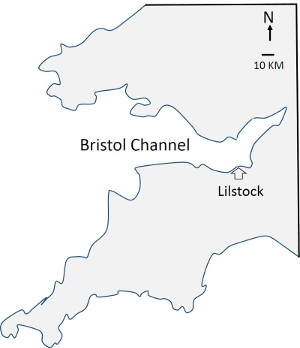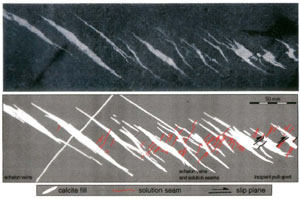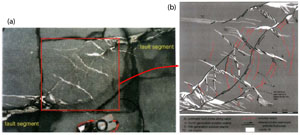| |||||||
|
|
|||||||
|
|
|||||||
| Fractures in Bristol Channel, UK | |||||||
|
The nucleation, interaction and growth of strike-slip fault zones in the Liasic limestone exposed on a wave-cut platform at Lilstock in Summerset area (Figure 1), the Bristol Channel (UK) have been well documented (Peacock and Sanderson, 1995; Willemse et al., 1996; Willemse et al., 1997). In this example, there is a strong interplay between pressure solution, jointing (associated veins), and fault initiation and development. A prime role of the pressure solution seams is to provide potential weak surfaces for faulting. Several generations of pressure solution seams and their shearing have been recognized as summarized below.
A schematic model for the fault development is shown in Figure 2. The incipient shear zones consist of arrays of en echelon filled joints or veins (Figure 2a). These veins occur ahead of the fault tips and have little or no shear displacement. Closer to the fault, as the veins become longer and wider, the overlapping areas of the vein array, called bridges, bend and pressure solution seams form in the contraction arches of the bridges (Figure 2b and middle of Figure 3). With continued vein opening and shear along the vein array the bridge rotates, and one or more solution seams extend further. Eventually the solution seams are subjected to shear due to increased rotation and start to slip (Figure 2c and right side of Figure 3). A fault zone formed by slip along the solution seams, linking the veins and producing pull-aparts (Figure 2d and far right of Figure 3). As shear increases along the pressure solution seams, the pull-aparts widen. With further shear along the slip planes, the pull-aparts widen and a second generation of solution seams forms, preferentially concentrated at the tips of the slip planes, and orientated at a high angle to the fault zone (Figure 2e). As slip across the zone increases further, closely spaced sets of these seams may behave as the sliding surfaces similar to the bookshelf model for tilted blocks. This process produces antithetic slip across the second generation of solution seams (Figure 4f). The slip associated with this block rotation leads to the formation of splay joints and a third generation of solution seams at the tips of the sheared second-generation solution seams (Figure 2g). At this stage, the shear displacement is on the order of several centimeters and an irregular through-going break has been established. The fault zone, which has been progressively fragmented by opening-mode fracturing and pressure solution, contains numerous discontinuities with a wide variety of angles to the zone. Strike-slip faults hundreds of meters long and several meters of maximum displacement, form by the linkage of side-stepping faults segments. The fourth generation of pressure-solution seams develops preferentially in the contraction relay zones between side-stepping segments (Figure 4). Slip along the solution seams can lead to the generation of additional solution seams and splay joints. By this process, the relay zone becomes progressively fragmented as displacement accumulates. Linkage is achieved along a series of through-going, curved slip planes that are sheared fourth-generation pressure solution seams. There are two major difference between this example and the fault system in the Sierra Nevada granite. First, the veins in this example is an integral part of the faulting process, as opposite to an unrelated earlier event in strike-slip faulting in the granitic rocks of the Sierra Nevada, California (USA). Second, splay pressure solution seams form and link the adjacent veins and act as weak planes for slip as opposite to splay joints linking sheared joints in the Sierra Nevada examples. This is a direct consequence of the initial joint and vein patterns relative to loading configuration. In this example, the left-stepping echelon veins are subjected to right-lateral shearing, forming an echelon pattern with contraction steps. Since the overlapping region is subject to a higher degree of localized compression and limestone is readily deformable under high enough pressure, pressure solution seams occur there. | |||||||
| Reference: |
|||||||
| Peacock, D.C.P., Sanderson, D.J., 1995 Willemse, E.J.M, Peacock, D.C.P., Aydin, A., 1996 Willemse, E.J.M, Peacock, D.C.P., Aydin, A., 1997 |
|||||||
|
Readme | About Us | Acknowledgement | How to Cite | Terms of Use | Ⓒ Rock Fracture Knowledgebase |
|||||||



